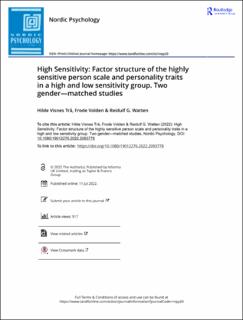| dc.contributor.author | Visnes Trå, Hilde | |
| dc.contributor.author | Volden, Frode | |
| dc.contributor.author | Watten, Reidulf G. | |
| dc.date.accessioned | 2022-11-21T09:09:26Z | |
| dc.date.available | 2022-11-21T09:09:26Z | |
| dc.date.created | 2022-07-12T12:19:19Z | |
| dc.date.issued | 2022 | |
| dc.identifier.citation | Nordic Psychology. 2022, . | en_US |
| dc.identifier.issn | 1901-2276 | |
| dc.identifier.uri | https://hdl.handle.net/11250/3033060 | |
| dc.description.abstract | Sensory Processing Sensitivity (SPS) is a heritable personality related trait which includes sensitivity to a variety of stimuli, emotional, cognitive, and behavioural reactions such as strong positive and negative emotional responses, deep cognitive processing of stimuli, and empathic behaviour. Two studies are reported. Study 1 investigated the factor structure of the Highly Sensitive Person scale (HSP) and gender differences in HSP. Study 2 described differences in Big Five personality traits between two HSP groups. Study 1 comprised a sample of adults, mostly university students, matched on gender (N men = 548, N women = 548; total N = 1096). Study 2 was based on a sample consisting of a High (N = 164) and Low (N = 164) HSP group also matched on gender (N men = 82 and N women = 82 in both groups; total N = 328). There were no age differences between men and women in the two samples. Results from Study 1 showed a correlated three-factor solution: The first factor reflected excitability, easily aroused, negative emotional reactivity, frustration, avoidance of upsetting situations and childhood shyness. Factor 2 comprised low sensory threshold and sensory discomfort. Factor 3 captured intensity of aesthetic reactions, preoccupation with details in the environment, and socio-emotional sensitivity. Gender differences were found, women had elevated HSP scores on all scales, also when controlled for personality traits. Study 2 showed that the highly sensitive individuals had a unique personality trait profile compared to low sensitives. They had higher scores on neuroticism, agreeableness, openness, and lower scores on conscientiousness. There were no differences in extraversion i.e., there was no tendency towards introversion among the high sensitives. | en_US |
| dc.description.abstract | High Sensitivity: Factor structure of the highly sensitive person scale and personality traits in a high and low sensitivity group. Two gender—matched studies | en_US |
| dc.language.iso | eng | en_US |
| dc.publisher | Informa UK Limited, trading as Taylor & Francis Group. | en_US |
| dc.rights | Attribution-NonCommercial-NoDerivatives 4.0 Internasjonal | * |
| dc.rights.uri | http://creativecommons.org/licenses/by-nc-nd/4.0/deed.no | * |
| dc.title | High Sensitivity: Factor structure of the highly sensitive person scale and personality traits in a high and low sensitivity group. Two gender—matched studies | en_US |
| dc.title.alternative | High Sensitivity: Factor structure of the highly sensitive person scale and personality traits in a high and low sensitivity group. Two gender—matched studies | en_US |
| dc.type | Peer reviewed | en_US |
| dc.type | Journal article | en_US |
| dc.description.version | publishedVersion | en_US |
| dc.source.journal | Nordic Psychology | en_US |
| dc.identifier.doi | 10.1080/19012276.2022.2093778 | |
| dc.identifier.cristin | 2038073 | |
| cristin.ispublished | true | |
| cristin.fulltext | original | |
| cristin.qualitycode | 1 | |

